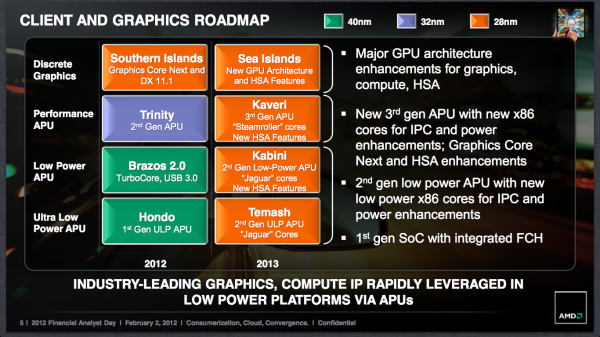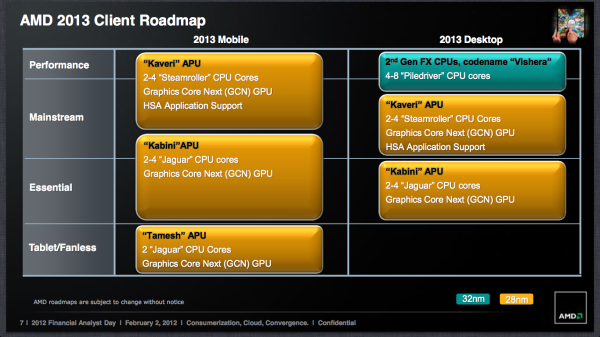Understanding AMD's Roadmap & New Direction
by Anand Lal Shimpi on February 2, 2012 6:16 PM EST- Posted in
- CPUs
- AMD
- Trade Shows
- AMD FAD 2012
We've been providing live coverage of AMD's 2012 Financial Analyst Day from Santa Clara today, but if you want a summary of the company's strategy under new CEO Rory Read you've come to the right place. Below you'll find links to everything we've published from AMD's FAD 2012:
AMD's Rory Read Outlines AMD's Future Strategy
AMD Outlines HSA Roadmap: Unified Memory for CPU/GPU in 2013, HSA GPUs in 2014
AMD is Open to Integrating 3rd Party IP in Future SoCs
AMD's Financial Analyst Day 2012 - Mark Papermaster, SVP & CTO Presentation
AMD: Flexible Around ISA
AMD Nods at Shorter Design Cycles, More Synthesized Designs
What AMD Views as Important: Tablets, Servers, Notebooks & GPUs
AMD & Compal Show Off 18mm Trinity Notebook
AMD's 2012 - 2013 Client CPU/GPU/APU Roadmap Revealed
AMD's 2012 - 2013 Server Roadmap: Abu Dhabi, Seoul & Delhi CPUs
AMD is Ambidextrous, Not Married to Any One Architecture, ARM in the Datacenter?
AMD's Tablet Architectures: Hondo at 4.5W, Future Sub-2W SoC
The name of the game for AMD in 2012 is execution. Far too often at previous AMD events we'd see a roadmap with no indication of whether or not AMD would actually stick to it. Plans were always aggressive and made sense, but execution rarely mirrored what was promised on paper. AMD in turn ended up delivering CPUs sometimes years after they were promised, which obviously didn't help grow the company.
Over the past few months Rory and his new management team at AMD have been restructuring the company to improve execution. As a much smaller company than Intel, AMD had an almost impossible task competing in the x86 space, but AMD should have also been far more agile than it was given its size. AMD's restructuring is supposed to fix these agility and execution problems. The proof will be in how well AMD is able to introduce products over the next 24 months.
As far as the roadmap goes, AMD already laid out what it hopes to accomplish by 2013. The best way to summarize AMD's next two years is: APUs and servers. On the APU side, we'll get updates to all of the current lines this year (Trinity & Brazos 2.0), but we'll also get a new 4.5W APU (Hondo) aimed at the Windows 8 tablet market. Now 4.5W is a bit high for a tablet but AMD has plans to bring even lower power architectures to market in the future. Next year we'll also see the first single-chip solutions from AMD: Kabini and Temash will integrate the I/O controller (SATA, USB ports, etc...) on-die. Intel is doing something similar with Haswell.
The big transition will happen next year, as AMD moves its entire APU stack from 32nm SOI to a bulk 28nm process at Global Foundries. This is an important move as it signifies the use of more easily synthesized designs, which enables AMD to bring out APUs in a quicker fashion and with lower design costs. Effectively everything follows the path laid by Brazos/Bobcat at this point. Note that AMD will be shipping 28nm APUs while Intel is well transitioned to 22nm, a gap that AMD has no intentions on narrowing. The process technology gap has almost always existed between AMD and Intel, but now AMD is taking a firm stance in saying that it has no intentions to blindly pursue the closing of that gap.
What once was a 3+ year design cycle for AMD CPUs and APUs now shrinks to less than 24 months (maybe even as short as 18 months) as a result of this migration to more easily synthesized designs. If this sounds a lot to you like the old GPU design cadence don't be surprised. AMD's APUs are, after all, largely made of GPU transistors that have always strayed from custom logic where possible. The big change is simply doing more non-custom x86 design.
Obviously AMD's ability to execute on this roadmap will depend heavily on Global Foundries delivering good yields at 28nm, however AMD does seem fairly confident at this point. That being said, 2013 is a very broad timeframe. Executing on the above roadmap sooner rather than later in 2013 will be the difference between a competitive AMD and one that's quickly written off.
I don't believe a move towards easily synthesized architectures is necessarily a bad thing. As long as AMD can deliver good performance at competitive prices the process technology really doesn't matter as much. Typically process technology was used as an enabler of good performance but as a newly fabless semiconductor, that strategy doesn't necessarily apply to AMD - at least not across all market segments. In other words, what works for Intel may not work for AMD.












84 Comments
View All Comments
jabber - Monday, February 6, 2012 - link
Once again...if you are spending more than $10 you do your homework to check it will do the job you want it for.That's just basic common sense.
I guess you found that microwave oven you bought to clean the dishes didn't work out so well?
I bet if you looked up on certain IT forums you would have found plenty of folks who also didn't do their homework and also were struggling with AMD/Blackmagic.
Really in this day and age there isn't an excuse for it.
wifiwolf - Friday, February 3, 2012 - link
That would be as bad as if I bought a i5 2400 and a Nvidia 560 cardbut really wanted run render a lot (which seems you want to anyway) and use 4 monitors at the same time. In that case your current build would be best.
Let's just say you can't have it all without paying twice as much.
Marburg U - Friday, February 3, 2012 - link
Do you really think AMD can compete with designers as such as samsung\qualcom\TI\Boradcom in the ARM universe? Preposterous.For sure they won't pursue the SoC market... they haven't got any single IP which may be of some use in the SoC niche. Nvidia and Intel, for example, have just spent billions in aquisitions of wireless solutions. AMD have no money to spend on anything.
High end desktop\workstation\server... they will never be able to compete with intel.
AMD have only 2 proficiencies: 1) ATI and 2) an x86 license. it's quite clear that the only thing they can do is low cost APUs for consumer personal computers and GPUs.
BitJunkie - Friday, February 3, 2012 - link
I think you are missing the point. There is a big difference between the technology IN the product they are delivering and the WAY they end up at that product.The problem with most tech companies is that they get stuck on the technology and don't land a reliable way of delivering a product.
I'm not going to put a single penny in AMD until I can see the following:
1) They have a tight spec and set of objectives for each product and iteration.
2) They set up a proper matrix organisation with competent technical and commercial managers and execute each product in a safe and reliable way.
3) They set up a process of feeding back lessons learned from one project cycle to the next and implement a reliable continuous improvement programme
4) They start USING tech as a way of delivering their products, not as a centrepiece
A silicon fabrication process node is not a product, the product is the design, and the logic included in it which just so happens to be delivered on a process.
If they get that right, then they will be able to pick their technology and their process and be able to excel in any space.
Is it really that hard to see?
Yahma - Friday, February 3, 2012 - link
Now that competition in the enthusiast market is effectively dead, Intel has no reason to continue to innovate at the high end, let alone lower prices.We will go back to the days of the 386/486 when Intel ruled, and prices stayed high, while there were little improvements at the top end.
Its already starting to happen. Ivy Bridge is supposedly only a few % faster on the CPU side than its predecessor Sandy Bridge. Ivy Bridge is likely to be the last iteration on the high end in a long time. Haskell will probably be delayed/cancelled or neutered. Prices on anything faster than an Intel 2500k will be insane!
Thats what no competition brings.
Impulses - Friday, February 3, 2012 - link
Umm, IB wasn't supposed to be significantly faster than SB, just more efficient... Look up Intel's tick tock strategy. They're at the same pace they've been at for a few years now. If Intel stops innovating on the high end they just risk AMD catching up and they cannibalize their mobile sales unto which every new design trickles down... So that's not gonna happen. They could squeeze the desktop market and raise prices as they keep bringing out new designs, but they'd be squeezing a shrinking market dry for short term gain instead of using it as a proving grounds for mobile.seapeople - Saturday, February 4, 2012 - link
Intel's competitor in the desktop/laptop space hasn't been AMD for a while now, it's been the threat of smartphones/tablets or other small, low power devices. Intel has acknowledged this with their ultrabook push, and the logical course of action is to decrease the power consumption of their top line processors rather than increase performance.Think about it, if Ivy Bridge can perform the same as Sandy Bridge while using 25% less power, then the 6 hour battery life on that shiny ultrabook becomes closer to 8 hours, OR the battery size is reduced, the ultrabook still has 6 hours of battery life, but instead weighs 1.8 lbs instead of 2.0 lbs. Those are tangible product benefits that will make people more likely to buy Intel in today's world, whereas if Ivy Bridge instead kept the same power envelope and upped performance by 25% then you'd have the same ultrabook that's just 25% faster and nobody would care because it's already light years faster than an Ipad anyway.
I predict in 5 years the newest Intel top-end processor will only be 10-20% faster than Sandy Bridge but will use one-third to one-half the power.
tipoo - Monday, February 6, 2012 - link
"I predict in 5 years the newest Intel top-end processor will only be 10-20% faster than Sandy Bridge but will use one-third to one-half the power."Err, no. I'd bet dollars to donuts their next "tock" will beat that 10-20% already. Just because power consumption is going down doesn't mean they can't improve performance too, we have more than enough proof of that. 5 years is a lifetime in the processor industry, 5 years ago we had Core Solo and Core Duo and were just transitioning away from the Pentiums.
name99 - Friday, February 3, 2012 - link
"AMD's Heterogenous Systems Architecture (HSA) plans to change that. AMD wants to see the creation of a virtual ISA that will be the backbone of a software layer that can schedule application workloads on any combination of underlying CPU/GPU hardware, regardless of the ISA of the hardware."Wasn't this program called Java 20 years ago? How did that turn out?
Oh, right, because it now also targets GPUs, this time it's going to be different.
Good luck guys, but I can't say I'm optimistic about your chances.
arjuna1 - Friday, February 3, 2012 - link
Ah crap, meant "Kaveri", not Vishera.